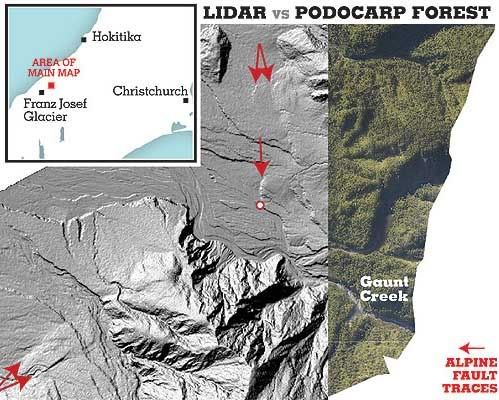Kiwithrottlejockey
Admin Staff
XNC2 GOD

Posts: 32251
Having fun in the hills!
|
 |
« on: November 21, 2011, 09:06:53 pm » |
|
Lidar filters bush to reveal Alpine FaultBy PAUL GORMAN - The Press | 5:00AM - Monday, 21 November 2011 TECHNOLOGY that strips away thick bush has given scientists a better understanding of the nature of the Alpine Fault, one of New Zealand's biggest hazards. TECHNOLOGY that strips away thick bush has given scientists a better understanding of the nature of the Alpine Fault, one of New Zealand's biggest hazards.
An aerial survey of the Alpine Fault using Lidar (Light Detection and Ranging) — in which pulses of energy are fired down at the ground and bounce back — has revealed subtle features in the landscape formed by fault movement over hundreds and thousands of years.
Dense West Coast podocarp forest and under-storey vegetation make it almost impossible for researchers to find parts of the fault on foot.
The survey, flown and processed by NZ Aerial Mapping this year, covered a 34 kilometre-long and 1.6km-wide, high-uplift section of the fault from Whataroa to Franz Josef. Lidar was also used in the natural hazards research platform-funded project to investigate about a 30km stretch of the western part of the Hope Fault from the upper reaches of the Hurunui River to the upper Hope River, much of it under beech forest.
GNS Science earthquake geologist and project leader Robert Langridge said Lidar had been used effectively in California to study parts of the San Andreas fault system underneath redwood forest.
"Without causing deforestation you are making a map that is removing the vegetation ... through some very complex filtering. What you tend to see is very subtle things you would never see in aerial photos or by crashing through the bush in the South Island to find them."
The results of the collaborative work between GNS Science and young researchers at Canterbury, Otago and Victoria universities had thrown up a few surprises, Langridge said.
Earlier work had suggested the central section of the Alpine Fault had sections split into short, stepped, segments about one-kilometre long because of the way the fault reacted with the Earth's surface.
"With Lidar we were able to confirm that theory, [and] also show some of the traces ... were quite extreme in their strike direction, accommodating lots of strike-slip [movement] and considerable amounts of reverse movement. So it has been able to confirm things that we sort of only dreamed about."
At Gaunt Creek, the Lidar had revealed fault traces oriented north-south.
Excavation of a terrace across the fault there showed it last moved in 1717, confirming the date of the most recent rupture, he said.
"There are few places along the fault where we have such good evidence for the faulting during the most recent event."
The density of the survey points had been lowered for the Hope Fault work because the forest cover was less thick.
A student working on the Hope had discovered the zone of ground deformation was wider than it would be with just a single fault. The Lidar allowed all the secondary faults to be mapped.
If funding was available, it would be wonderful to fly along most of the Alpine Fault's 650km length, he said.
"With Lidar we are realising a primary set of data to build other projects off. By knowing where the fault is and main traces, you can do slip-rate studies, trenching studies to date past quakes, and think about where to site deep-drilling projects."
"It's a new form of mapping technology that is going to lead the way for a decade or so."http://www.stuff.co.nz/the-press/news/christchurch-earthquake-2011/6002393/Lidar-filters-bush-to-reveal-Alpine-Fault
|
If you aren't living life on the edge, you're taking up too much space!   |
|
|
|
|
|